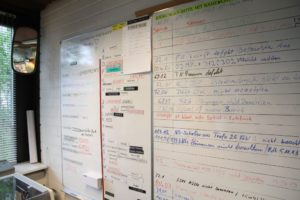The University's immune system

Tuesday, 2.39 p.m. Manfred Herzog, an employee at the University’s central control room, picks up the phone and speaks to a caller in a flustered state who wants to report smoke rising from the Südgelände campus. The first idea that comes to mind is that there is a fire. Quick action is needed now. By asking the right questions and consulting the building plan on the wall, Herzog finds out which building is affected. What kind of work is done there? Does it involve hazardous substances? What could have caused the fire? Which experts must be informed in the event of an emergency? Are people, animals or experiments in danger? Herzog sorts through these questions while calling the building in question. The colleagues there have not noticed any fire. Then Herzog remembers: the building’s roof is currently being repaired. The smoke might be coming from the welding work on the tar paper roof. And he is right, thank goodness.
Where it all comes together
The central control room is the University’s immune system. ‘It is our task to prevent any technical damage at the University,’ says Herzog. ‘Everything comes together here and is co-ordinated from here.’ At the start of each shift, Herzog gets an overview of the reports that have been received. He talks to his colleague who had the shift before him, checks e-mails, tables and charts on the four screens at the desk and sorts through the reports which keep coming in through the printer. It is quite a challenge to stay on top of everything. The police and fire service are contacted from the central control room and craftsmen, technicians and other experts are informed where they are needed. They have to be familiar with where every building is so as to be able to react quickly in emergencies.

The central control room is responsible for 240 buildings, including the buildings in Erlangen, Nuremberg, and Uferstadt in Fürth, as well as the telephone system at Universitätsklinikum Erlangen. With so many buildings and technical systems to maintain there is never a quiet minute in the central control room. Report after report comes out of the printers, messages flash on the computer screens and the telephones ring non-stop. There have been days when almost 20,000 reports were received. On a quiet day there are only around 1,000 reports. ‘On a more relaxed day, we may have one quiet hour,’ says Herzog.
Humans first, then animals, then equipment
The central control room is responsible for a wide range of possible damage, from squeaking door hinges to chemical accidents. ‘The central control room is always manned, on weekends and holidays as well.’ This is necessary because expensive equipment is easily destroyed by unfortunate accidents, meaning that the research findings are destroyed with it. If the power supply is cut off or a laboratory’s cooling system stops working, many months’ or even years’ work is destroyed. ‘Our priorities are as follows: humans first, then animals and then expensive devices.’
Manfred Herzog has been working at the University’s central control room for 13 years. Before that, he worked at a control room in a power plant. Thanks to his many years of experience, he knows exactly when a situation might get dangerous and quick and effective action is required to prevent it from getting worse. ‘When I receive a report of a fault which involves water I immediately check it more closely because water can cause extreme damage,’ Herzog explains. The instructions stipulate precisely how to respond to every possible situation. These instructions are close at hand in the filing cabinet. This is particularly important for more severe incidents.
Many reports later, at 10 p.m., Manfred Herzog’s shift is over. In addition to the fire report and various repair requests, Herzog had to provide psychological support to a man who was trapped in a lift until the lift was fixed. ‘The job is very versatile. Even after so many years, I still experience new things.’
Interesting places at FAU
There are many interesting places at FAU. We will introduce them to you in our blog ‘Interesting places at FAU‘.